- Home
- About us
- Products
- Dealer Enquiry
- Contact Us
- 044 -2486 1994
- +91 99623 98222
- sales@nantech.in
- REQUEST A QUOTE
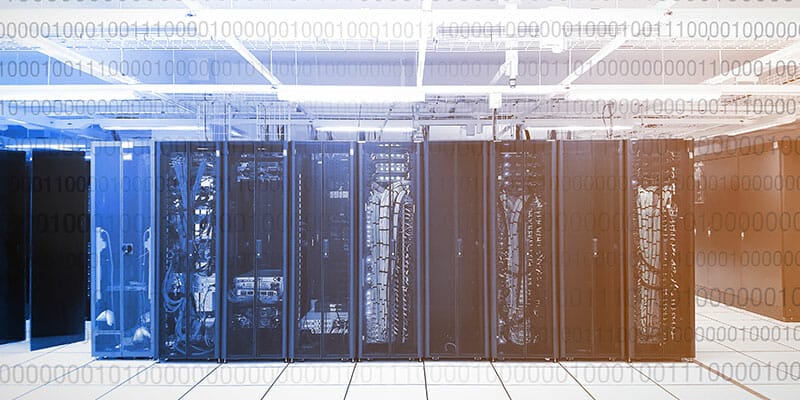
The rising temperature in the peak of an Indian summer sets the perfect tone for our blog topic- Precision Air Conditioning for IT applications.
Until recently, data centre managers purchased precision air conditioning systems primarily driven by the need to maintain precise temperature and humidity control in IT spaces. However, ASHRAE (the American Society of Heating, Refrigerating, and Air-Conditioning Engineers) revised and expanded the acceptable temperature and humidity range for sensitive IT environments.
With thermal management for IT systems remaining a critical priority, the requirement for precision air conditioning is a must. What is precision air conditioning all about?Also known as data centre-grade cooling systems, Precision ACs (PAC) like Emerson precision air cooling systems are a special kind of air conditioning equipment that maintain precise temperature and humidity conditions for critical applications such as:
These exclusive air conditioners are built to maintain temperature and RH in sensitive environments like data centres and IT spaces. Even if precise temperatures and humidity set points are no longer mandatory, the PAC plays a vital role in ensuring data-sensitive devices remain operable even with sophisticated servers' high heat.
IT is an ever-evolving industry. With automation and digitalisation becoming the norm of the day, enterprises and organisations are making more room to house bigger and more powerful equipment to run their IT network environments. The more powerful the equipment, the more work efficiency it creates. But, this high-end equipment has a big risk: They generate a lot of heat.
Now, imagine an IT network room with these powerful servers connected to more than a dozen computer systems. The equipment-generated heat gets trapped in the space, and without adequate ventilation, the temperature can escalate to dangerous levels that shorten the lifespan of other devices.
Here’s where PACs come into play. These devices allow sensitive IT equipment to remain running and operable and prevent any downtime. Now, you may wonder if commercial air conditioners aren’t good enough to serve the same purpose. Of course, many buildings and industrial facilities rely on conventional AC systems. They are, without a doubt, very effective in controlling room temperature and humidity. Commercial air conditioners and Precision air conditioners serve different purposes. They are also designed differently.
Let’s break down the functional specifications of a precision AC.
1. Manage IT equipment's concentrated heat load
Most IT office spaces are not originally designed to house high heat-generating equipment but have no other option but to do so. High-performance equipment makes conventional cooling solutions ineffective and creates an unsuitable working environment.
Precision air conditioners, however, are specifically designed to handle high heat trapped in small, congested areas and expel it in whatever method the system uses.
2. Operate non-stop, round-the-clock.
Even if the outside temperature is cool and comfortable, IT spaces require air conditioning to remove the trapped heat. Even in such scenarios, you cannot use commercial air conditioning for IT applications because they are designed to operate when the outside temperature is roughly 55 degrees Fahrenheit.
The additional challenge with data grade centre cooling systems is that they will automatically shut down after hours. In such cases, the computer equipment will remain vulnerable to electrical or other issues.
Such problems are uncommon with precision air conditioners, mainly because they are designed to work non-stop, irrespective of the outside temperature. With this feature, you won't have to worry about your computer networks overheating.
3. Air filtration and volume
Compared to a less dense "comfort" application, a high-density heat load in a small space requires more air exchanges. Ordinary air conditioning cannot provide the volume of air needed by IT equipment. Normal office spaces require only two air changes per hour, but an IT room requires multiple changes per hour. This air volume is compulsory to handle temperature fluctuations, hot spots, and ideal heat ratios within the IT environment.
4. Control room temperature to the best of their ability
A conventional AC system’s capacity is split between cooling the space and eliminating moisture from the air. This combination creates a comfortable, optimal temperature when the temperature rises. About 40% of the system’s capacity regulates the humidity in this case. The rest of the capacity, which is 60%, is dedicated to regulating the air temperature and keeping the place cool.
This problem can result in a great deal of waste in IT spaces because IT equipment generates dry, intense heat. This means it doesn't require nearly as much capacity for humidification.
Think about it: What’s the point in buying a 100kW commercial air conditioner to cool an IT load of the same capacity? The system will most definitely fail because system can generate only about 60% of the cooling capacity.
Here’s where PCAs make a difference because they are designed with a heat ratio of 0.90%, which is the optimal cooling capacity required to cool IT devices. The remaining 10% capacity removes humidity entering the room whenever the doors open and close. Nowadays, thermal management systems offer a better heat ratio of 0.95%.
Cooling equipment works best only when they align with the purpose, equipment type and room size. A simple ceiling fan will suffice if you use a single PC or laptop. However, to run an industrial or business server network, you need higher-density equipment requiring a dedicated cooling system like precision ACs.
If you are interested in investing in emerson precision air cooling systems for your IT environment, contact our Nantech professionals in Chennai for expert guidance.
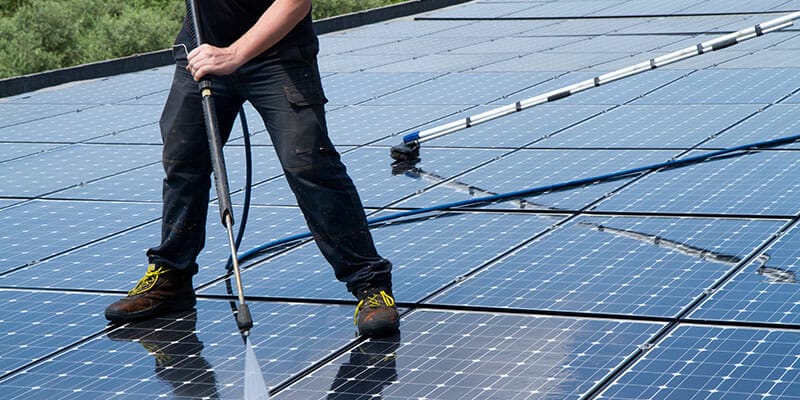
Solar panels are gaining popularity among the masses for their sustainability and eco-friendliness. As efforts to reduce the environmental damage continue to increase, solar panels and other sustainable forms of energy are gaining a wider consumer base as a cheaper and more efficient fuel than coal and other fossil fuels. In this article, we take a closer look at solar panels and ways to use and maintain them efficiently.
Solar panels and solar power gain over other non-sustainable forms of energy in three important ways. They are:
It is now common knowledge that energy consumption methods commonly practised in homes and businesses generate large amounts of hazardous waste. This affects the environment at many levels. The use of solar panels eliminates this pollution by storing and using the sun's energy to power common household appliances like lights and heaters. Here's how the use of solar panels can be beneficial to the environment.
Using solar panels reduces:
Using solar panels can help reduce our dependence on energy sources that produce hazardous chemical wastes like oil sludge and coal ash which increases the presence of metal compounds in the environment to dangerous levels.
It is now commonly known that traditional methods of electricity production have had devastating effects on the environment. Power plants that generate electricity release dangerous toxins like carbon dioxide, nitrogen dioxide, mercury and particulate dust. This has led to phenomena like global warming and climate change, contaminated fisheries, acid rains and smog.
The use of solar panels can reduce our dependence on such toxic power sources. Even limited use of power panels energised by the sun can significantly impact total energy production and consumption.
Water bodies have also suffered tremendously from pollution because of our dependence on coal-based power plants. They release toxins like arsenic, boron, selenium, mercury and cadmium into water bodies, effectively poisoning them. Release of large amounts of warm, low-oxygenated water into water sources has only added to the damage. The adoption of solar energy can reduce our dependence on these dangerous, unsustainable sources of energy, and also give the environment a chance to recover from the damage.
Coal-based power plants raise the need for surface mining, bringing profound environmental challenges to the forefront, even before coal-based energy is produced. The energy produced by solar panels can eliminate the need for coal-based energy, thus cutting down on the impact on the environment.
Solar panels are fundamentally durable and sustainable sources of energy. They can withstand adverse weather conditions. But we can take a few steps to maximise their life and protect them from unnecessary damage. Here are seven simple ways to protect your solar panels:
Periodic cleaning is necessary to maintain the optimal functioning of solar panels. Washing down with a hose pipe needs to be supplemented with a thorough scrubbing with a soft rag or sponge. Experts recommend using the rag or sponge attached to a pole from the ground level.
Falling trees are not the only things that can damage solar cells. Branches, leaves and twigs that fall continuously can scratch the surface of the cells and reduce their efficiency. This will lead to a need to replace the cells, which can be expensive.
The sealants on the solar panels can wear with time. This will affect their functioning since water and dust can seep through the gaps into the PV mechanism and cause short-circuiting. Faded sealants can be repaired, preferably with a silicon-based sealant that is effective and easy to use. Regular inspection will help you identify areas that need repair. Major wear and tear in significant places like the area between the roof and panels will have to be replaced.
Natural disasters and similar occurrences cannot be prevented. But there are measures one can take to control the damage. Many businesses and homeowners install lightning rods to protect solar cells from lightning strikes. Even indirect strikes can cause a power surge that can harm the panels and people.
Installing solar panels requires proper grounding for protection and proper functioning. Anchoring is also an important step in proper solar panel installation. As the name suggests, anchors are tools that hold the solar panels in place, even in the roughest weather. Panels that are mounted in the ground require proper earth-anchors to withstand any weather.
Natural disturbances to the smooth functioning of the solar panels can come in many forms:
It is recommended that you instal mesh wiring and other protective measures to prevent such damage.
Retaining walls are supporting structures made of pre-cast concrete, which can form an impenetrable support against weather and climatic conditions like rains and storms. These can last for decades and work to strengthen the foundation on which the panels rest. They will be a good investment if you live in places that receive large amounts of rainfall or experience other adverse weather conditions.
Solar panels are considered permanent fixtures when installed on the roof. They can be insured against damage due to fire or water and theft or vandalism. Many companies also provide insurance for accidental damage.
There are many advantages to investing in solar energy. It is one of the most beneficial sources of power - it is endlessly sustainable, cost-effective, and energy-efficient. There are long-term benefits to the environment and ultimately to your health and well-being as well.
For all these reasons, it will be wise to invest in solar panels for energy production in your home. For maximum benefit, follow the tips discussed above to enjoy the benefits of solar panels for many years to come. Professional UPS manufacturers like Nantech Power Systems in Chennai can be of great help for best-fit recommendations and installation.

With unreliable grid power supply being the norm of the day, most businesses and industries have equipped themselves with generators or UPS. Some of them are clever enough to invest in both to ensure a reliable chain of power 24/7.
The world stands divided over which power solution is better- the Uninterrupted Power Supply (UPS) or the generator. As one of the leading UPS manufacturers, we at Nantech, Chennai, suggest combining the best of both worlds. UPS and generators are both essential parts of any power infrastructure. When integrated, they provide you with a seamless, highly-effective, and safe power solution for your business.
In this blog, we've explained everything you need to do to gain the combined power of your UPS and generator. But here's a small intro about both power sources before we venture into the details.
Popularly called the UPS, the Uninterruptible Power Supply is an electrical apparatus that provides backup power when the main power supply is compromised. From powering a small household to running your entire computer system, the UPS is the top choice for many people.
The device contains batteries that automatically detect any loss of power and kick in to fill the gap within seconds or minutes. This results in assured continuity and functionality of your electric devices. Additionally, the UPS also safeguards your devices from unexpected power surges.
The backup generator can come in sizes as small as a suitcase or as large as a house. This self-powered device can generate electricity by converting mechanical power into electrical power. As per their capacity, generators can provide power for a longer period and effortlessly run heavy appliances.
Despite their differences in design and function, UPSs and generators are the most reliable solutions for uninterrupted power supply. Technology has simplified the way businesses operate and ease our reliance on electricity. Hence, it is easy to understand the outcome if these devices are used as a combination rather than stand-alone solutions.
If you plan to invest in both the UPS and generator, you need to know what to do to optimise these solutions and gain the most from them. Here are our guidelines.
The concept behind the UPS-generator combo is to use the UPS running as long as possible and then switch to the generator power. The generator will supply the power until the main supply is restored or until the system is properly shut down. Generators and UPS can work in perfect harmony as long as you implement these best practices.
Always assess your generator frequency when using the UPS-generator combo. Here's why:
If the UPS' input voltage and frequency exceed the set level, the UPS will slip into the battery mode. When connected to the generator, the UPS may consider a generator an unstable power source if its frequency range is too wide. As a result, the UPS will run permanently on the battery, resulting in the battery failing and dropping your load.
List the electrical devices you want your generator to power. This list includes the AC, lighting, computer systems, and other vital services. Now, assess if your generator can power these devices. If your generator isn't large enough, it will not be able to hold voltage and frequency within input tolerances.
Therefore, if you aim for potential growth with a generator-friendly UPS, it is wise to size up your generator whenever your budget allows it.
There are three fuel options to get your generator up and running:
Assess their pros and cons and choose the option that works best. For example, natural gas may slow down your generator and not deliver the desired outcome. Besides, you may have to invest in a larger generator in due course of time. On the other hand, propane is a better choice. However, it is diesel that takes the cake. It is the most preferred solution for generators with 50kW or more. On the downside, diesel costs are skyrocketing, and the fuel also has a short storage life.
Generally, there is an increase in temperature by 10 degrees Celsius when the generator operates. If the ambient temperature is around 40 degrees Celsius, the additional heat will damage your generator. You need to provision and scale your generator for more power to prevent this. You can:
People often overlook the need for strong electrical grounding, which could be a serious mistake when the UPS and generators are concerned. Electrical currents normally use the UPS to dissipate to the ground. Without proper grounding, they will bypass the UPS and use your cables and other devices to get to the ground. This sudden surge of electricity can cause equipment damage, shock hazards, and data loss.
To prevent this, you should:
There's a good reason why we offer this suggestion:
In standby and line-interactive UPSs, battery power prevents frequency variations from affecting the protected load. In contrast, a double-conversion, online UPS recreates the sine wave and filters frequency variations during normal operation. Therefore your battery life remains as good as gold.
Moreover, the online UPS corrects voltage and frequency deviations since it constantly rectifies AC to DC and then inverts it back to AC. Therefore, if you are looking for seamless generator integration, double-conversion UPS is the right choice.
Here are some more pointers to keep in mind to optimise your UPS-generator integration:
You can always rely on our experts at Nantech to provide technical advice and consultation with UPS-generator integration. Please feel free to reach out to us for the right guidance.
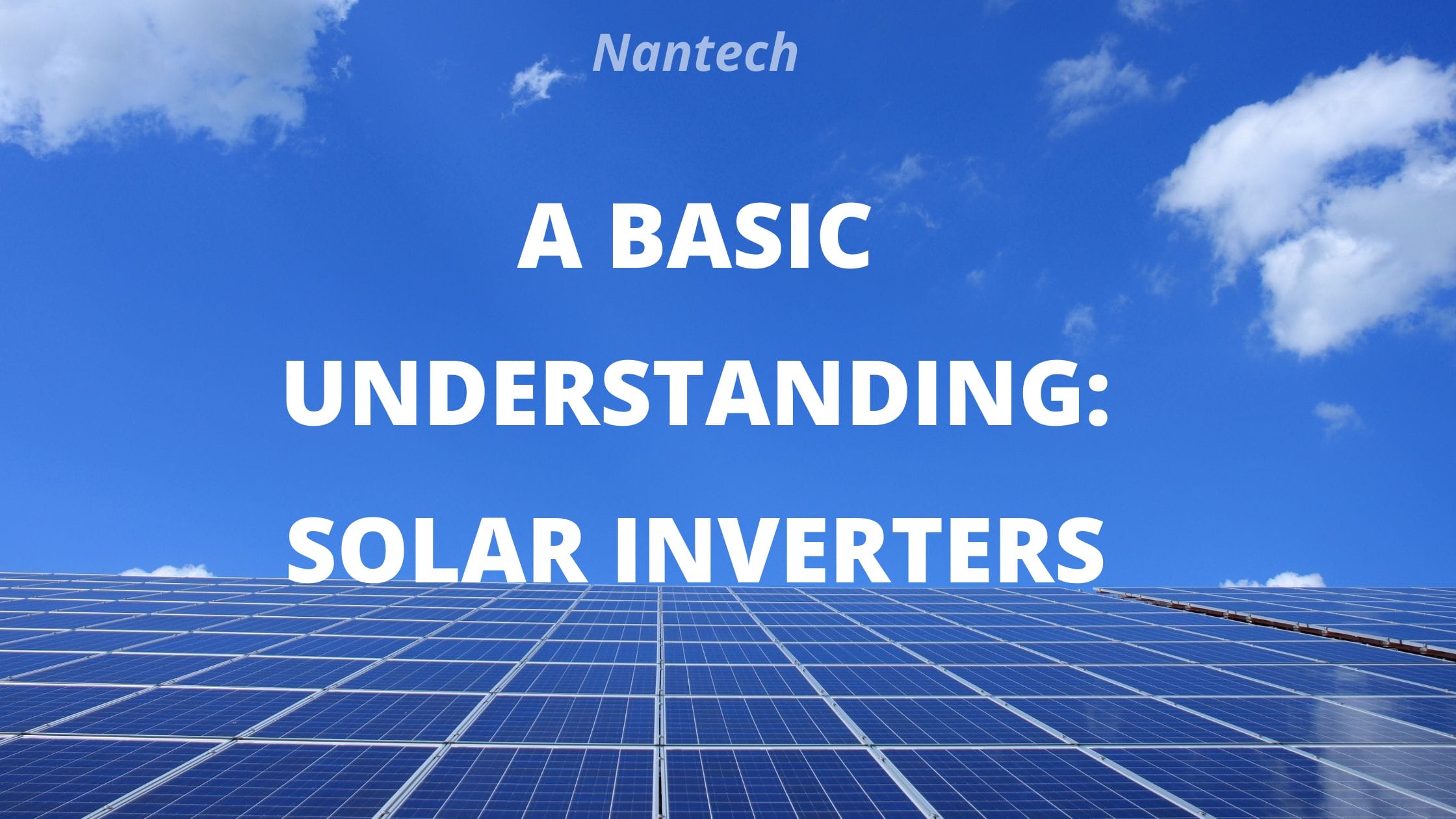
The type of electrical converter that can convert the variable direct current output of a photovoltaic solar panel into a utility frequency alternating current fed into a commercial electrical grid is known as Solar Inverters. Unlike the regular invertors, the solar panel charges the battery using solar power along with the electricity. For supreme efficiency of these solar inverters, systematic and consistent maintenance ensuring their efficacy is required for the long run of the machine.
Solar power installation provides for the benefit of the environment as this process requires no fuel burning and no radiation from energy production. Since it is pollution-free, most of the population will tend to purchase it as protecting the environment is considered the main motto of all individuals who are very well aware of the haphazardness of filthy surroundings.
The electricity generated from the solar panel can be used for smooth functioning of all electronic appliances in the home. The exorbitant current bill, which is unaffordable to middle-class people, has become more conducive to a solar heating panel. Sudden reduction in electricity bill makes everyone purchase this solar inverter as it reduces the cost of living and provides enough money for savings. It is the main heating mechanism of all homes, especially in foreign countries. Most housewives find cooking in solar energy less tiresome and an enjoyable pastime making the work less monotonous. Solar power cars are already in the market, which invariably reduces the fuel cost.
Since the sun is visible throughout the year, solar energy is a continuous process, and we cannot be in shortage of it at any point of time.
The electricity bill of houses reduces to a considerable extent after installing solar panels, which makes it more reliable and to gain more future buyers.
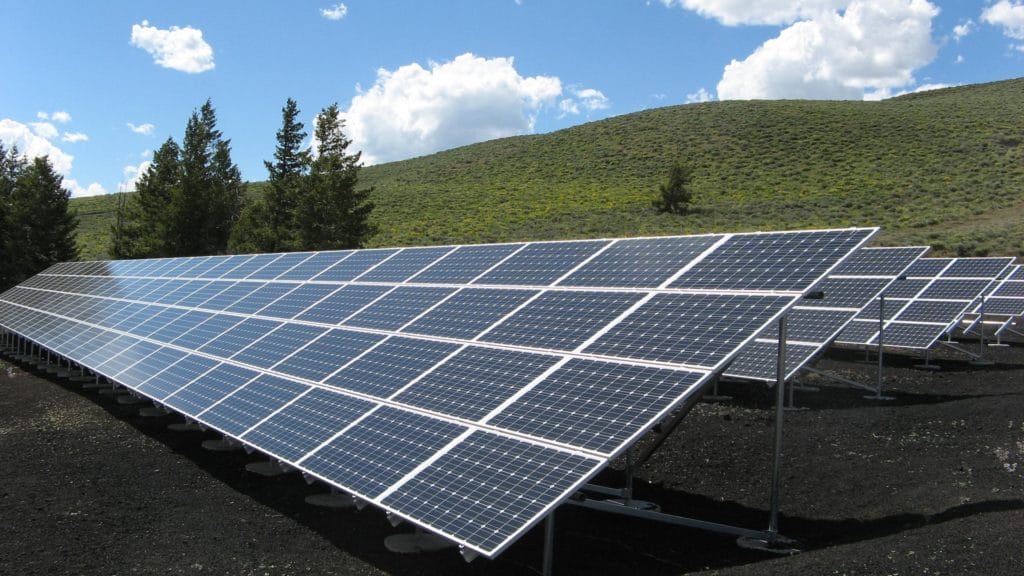
Greenhouse gases like carbon dioxide and methane, which cause pollution, are not caused by solar energy, making it eco-friendly.
We can store solar energy by increasing the number of batteries, which can be later used on a cloudy or a rainy day.
Once the solar power installation is done, it easily lasts for more than twenty-five years, reducing the maintenance cost.
It is extremely difficult to collect solar energy on a rainy or cloudy day as its efficiency decreases to such a low level during these days even though the energy can be stored through batteries.
To fit many solar panels, ample space is required in the roof area of the house. The place where the solar panel is kept should be accessible to exposure to direct sunlight. Hence solar inverters should be fixed only in places congenial for this.
Since solar inverters can't convert all their available energy into power, 100% efficiency is not arrived at by the constant use of these solar panels.
To put it in a nutshell, solar energy, which is gaining popularity through its technological development, will take some more years to reach the peak of its utility and to improve the quality of our life. By 2050, we can expect every single house to have a solar panel installed on its roof, which makes it an essential set up not an option.
If you are interested in purchase to check out Nantech’s ON-GRID, OFF-GRID and solar street light inverters.
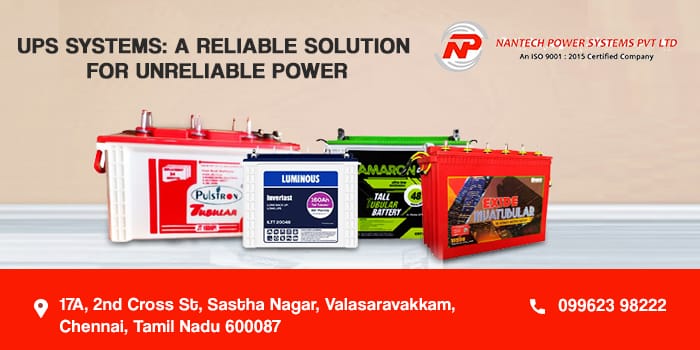
Power is anything but predictable. There is no saying when the slightest lightning can trigger a blackout, or the tiniest flaw can cause a surge that can knock out your expensive devices. Low voltages can leave you in desperation when you require that cool air from your air conditioner.
The unpredictability of power can also cause loss of property and money. What's worse is that power surges can even be life-threatening. This is where the indispensability of an Uninterrupted Power Supply comes into play. The UPS system not only provides undisrupted power but also shields your electronic appliances from a sudden power surge.
The UPS system is an omnipresent necessity in homes, businesses and commercial establishments. It plays an imminent role in protecting computer systems, telecommunication networks, machinery and delicate equipment that cannot handle the unpredictability of power. In a nutshell, the UPS keeps the work process flowing without a hitch.
Also Read: THE 101 ON SERVO STABILIZER
If you were under the impression that power surges and voltage fluctuations were the only problems that required a UPS system, you are not quite right. UPS dealers in Chennai list out various complications that the UPS can efficiently handle, making it an undeniable necessity in your homes and offices.
Types Of UPS: A detailed insight
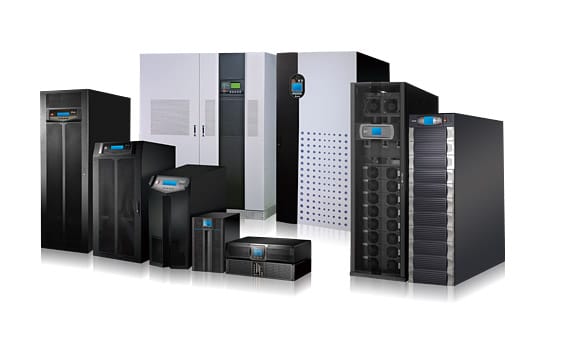
Three major types of UPS are commonly used for domestic and commercial purposes. We give you a detailed explanation of what they are and how they work.
1. Online double conversion
Also known as double conversion UPS, it is the most common UPS type that is used to power large data centres. Online double conversion UPS are highly reliable for the quality power that they supply. This support and protection are vital to handle critical loads and voltage fluctuations that can destroy a whole system of computers.
Application: large scale industries, small enterprises, LAN centres, IT parks.
2. Line-interactive UPS
A line-interactive UPS is very efficient in automatically regulating the voltage fluctuations. Widely used in applications where outages are rare but fluctuations are common, this UPS system supports a wide range of input voltage variations before switching to battery backup.
How it works: The line-interactive UPS continuously feeds power through a conditioner that keeps the battery charged at all times. It preserves battery life by using it as a last resort. Hence, the inverter becomes a part of the output and is always on "switched on" mode.
Applications: Personal computers and small range of electronic equipment.
3. Offline UPS
Also known as a battery backup or stand-by UPS, it is the most budget-friendly option. Engineered to power very basic loads and single workstations, the offline UPS is a viable option for small homes and businesses.
Applications: lights, fans, gaming consoles, domestic appliances.
Standard Features Of A UPS
How well do you know your UPS? Take a note of the standard features that every UPS is designed with:
The requirement and usage of the UPS define the kind of system you will need to choose. What is the intention of use? Do you need it for your home, office or business workplace?
These are the basic queries that will determine the size and running time of your UPS, depending on the devices you want it to power.
The line-interactive UPS is always a tad better than other types because it is built to switch from battery to utility power quickly. An online UPS is the best choice for bigger offices and homes as it can provide uninterrupted, clean energy.
Long backup runtime and the seamless switchover to battery mode are two essential factors that determine the worth of a UPs system. Your UPS should fulfil these criteria if they are to be used for powering sensitive devices
Your UPS dealer should provide you with post-delivery service and maintenance, should any issue arise. Additionally, ensure that the UPS is shock-proof and has user-friendly graphical displays to indicate its working status. Another critical point is to check if the UPS has ample power outlets to connect to the devices of your requirement.
Nantech - The Finest UPS Dealers In Chennai
An unexpected power disruption and the subsequent loss of expensive equipment is the last thing anyone wants to encounter. Where you buy your UPS also matters as much as deciding what model to buy. Being the fundamental part of an organization's efficient workflow, you must source your UPS from the best dealer in the city of Chennai.
Nantech Power Systems is your top choice to procure the UPS system of your choice. We supply top UPS brands with exceptional quality. Nantech also offers the best team of experts for installation and post-installation services. For the safety and security of your electrical equipment, always team with Nantech and get the best UPS systems. Get in touch with us @ sales@nantech.in

Typically, an industrial load is a three-phase load, and in a real setting, the voltage of the three phases is never balanced. A servo stabilizer is a closed-loop, motor-controlled stabilisation system that maintains a balance between the three phases.
They are called servo stabilizers because they use a servo motor for voltage correction. In some places, they are also known as Servo Controlled Voltage Stabilizer.
A Servo Stabilizer in Chennai has become mandatory for industries, commercial units and offices because they protect all electronics and machines from voltage fluctuations.
What are the advantages of servo stabilizers?
When compared to traditional stabilizers, servo stabilizers offer plenty of advantages in Chennai:
Because they use a servo motor, the output voltage is very accurate. Where input voltage differs up to 50% less or more, the output is + or – 1%! They are capable of supporting almost 5000KVA.
It is these outstanding benefits that make servo stabilizers popular for low-high rating appliances in Chennai and beyond!
Also Read: Busting The Myths Around Inverter Battery!

Servo stabilizers have three-phase and single-phase systems. They come in both air-cooled and oil-cooled units.
Both units work on the same principle. They will stabilize voltage and regulate output. For instance, if the stabilizer for an AC receives a low voltage, the buck-boost transform will increase it to the level necessary. Or if the power supply to the AC servo stabilizer is too high, the buck/boost transform will stabilize to the needed voltage.
Both oil and air units may work similarly, but the method through which they show efficiency differs in the two.
These show perfect stable output even when the voltage conditions are severely unbalanced. This is possible because they have an extremely durable motor-controlled stabilization system.
They are called oil-cooled because two things happen – lubrication and cooling. When an application gets heated, oil in the pathways ensures effective cooling of the system.
Air-cooled units are more expensive because of their design. They have a liner in aluminium alloy fins and fans for cooling above 50kVA. One benefit of these units is that they increase the durability of the machine or electric appliance. Moreover, they save you maintenance costs.
Here are some more differences between oil and air-cooled servo stabilizers:
| Servo Stabilizer: Oil cooled | Servo Stabilizer: Air-cooled |
|---|---|
| Cooling by the oil of coiling | Cooling by air of coiling |
| Capillary for oil rotation | Louvers in air-cooled |
| Heavy load in summer | Low load, heats up in summer |
| 30 kVA | 75 kVA |
| Weight 1.5% | Weight 1% |
| 0.8 power factor | 0.9 power factor |
Based on these differences, you can effectively select the right type of servo stabilizer you will need.
<h3">Where Can Oil and Air-Cooled Servo Stabilizers Be Used?
Uses of air-cooled servo stabilizers:
These can be applied in plenty of places, from individual houses to massive manufacturing plants. Air-cooled servo stabilizers are constructed with tailored sizes and capacities dependent on where they are needed:
Uses of oil-cooled servo stabilizers:
These are generally utilised for applications that need over 45kVA power. Air-cooled units are applied where the power required is less than 45kVA. There is an exception to this rule.
For industries that have very high dust like foundry dust or cotton dust and plants that have flammable particles, oil-cooled units are the best even if the requirement is for lower capacities.
This is essential because they prevent fire accidents and help with trouble-free performances.
Applications of Servo Stabilizers
Servo stabilizers can be used for house appliances like:
Commercial Areas
Hotels, malls, theatres, restaurants and more can utilise servo stabilizers for:
The best option for commercial places is usually an air-cooled servo stabilizer to prevent issues that come with voltage fluctuation in Chennai.
Servo stabilizers can be applied for a wide range of industries in Chennai to attain voltage efficiency:
If you are looking for reliable, competent, safe and most of all, advanced Servo Stabilizer in Chennai, then the best choice is Nantech. Get in touch to find the perfect unit for your requirements!
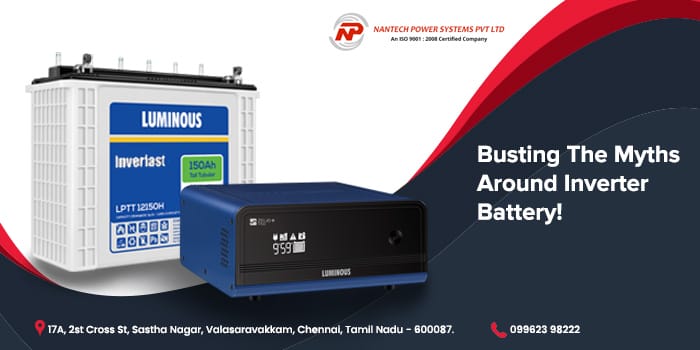
At Nantech, the one question we get asked and asked often by our customers in Chennai is if an inverter battery can power the entire home. To put the question to rest once and for all, we use this blog to bust the number one myth around inverter backup systems.
No, an inverter battery can not provide backup for the entire home, especially in the 21st century where houses are chock full of gadgets that need electricity to run. So, if you are buying an inverter battery in Chennai with the hope that it will provide power come hell or high water, read this blog to gain a better understanding.
Before we dive into why an inverter battery is not capable of powering the whole home, let’s look at what started the myth. There are some homes that can be powered by a battery system. These homes are few and far between because they are small and do not use power-hungry devices like swimming pools and air conditioners. As they place only a few demands on the battery, they can run on a battery backup for quite some time.
Also Read: The EV Revolution: Is Chennai Ready For It?
It is these small houses that have given birth to the myth that batteries can run an entire home. The reality is far from it. Typically, an inverter works best when it is used by the bear minimum appliances, and the battery capacity is rationed.
Why can’t inverter batteries power a whole house? There are two reasons why a home cannot be powered by a battery alone. One, an inverter battery is not powerful enough to give the kick start needed by large appliances to operate. Two, the lithium-ion batteries in an inverter do not have the energy capacity to supply electricity to a whole house for long, extended hours.
These two engineering limits make it impossible for an inverter to supply uninterrupted power to a modern house. The first thing that pops to the mind after reading the last paragraph is “why not invest in multiple batteries to solve the limitations on the power supply?”
The answer is simple: the cost of buying and installing several 20+ or 40+ kilowatt battery inverters is too high for the average homeowner. Because it is financially prohibitive, few opt for the solution. What most people do is take a more practical approach, which is to connect only critical loads to the inverter.
This means electric stoves, air conditioning, washing machines or dishwashers are not connected to the battery. Simple, small, and essential circuits like fans, lights and a convenience outlet are linked to the backup power supply. This ensures the continuous electricity is supplied until the main power comes back online.
Let’s say you still choose to connect your entire Chennai home to the inverter battery. In that case, how long will it be able to power all the appliances? The answer is not for a long time.
Here are a few figures to explain why:
High-power appliances like a central air conditioner, pool pump or electric stove consume boatloads of electricity. To be exact, it is 5000 watts, 2200 watts and 10,000 watts respectively.
Now let’s say you experienced a power cut in the evening, and your battery is down to 2.5-kilowatt capacity. It means the inverter only has enough juice to run the AC unit for half an hour, the pump for one hour and the stove for barely 15 minutes.
In short, high-power gadgets make it impossible for a battery to provide backup to the whole house for long hours. If you leave any one of these devices running, the battery will run out of power soon enough. In plain words, your home in Chennai will have no lights, and no fan, leaving you without a single luxury!
Yes, of course. People have been using inverter batteries in Chennai as power backups for a long time for a reason. The fundamental solution is to switch off all appliances that consume a lot of power when there is an electricity cut. It makes sure that no extra load is put on the battery and the house has continued power supply even for an entire night.
The problem with this solution is that if the cut occurs at night when no one is awake to shut off any extra appliances. The workaround to this is not to connect such devices to the backup in the first place. Since they are not linked to the inverter’s supply, then need not be switched off during a cut.
One more solution is to use battery backups coupled with solar panels. A well designed solar and inverter system can power your house for a long time. The keyword is well designed:
The Future Of Power Backups
In the coming time, smart homes will be able to address most problems that come hand in hand with inverters. Instead of relying on a human to shed any unnecessary load from the battery, the smart home will automatically be able to do so. One example is a smart electric panel that automatically manages the circuits in those and breaks those of large appliances in the event of a blackout.
Till the time such smart technology becomes commonplace in Chennai and takes care of the limitations of backups, the best and the most economical way to power your house is an inverter battery!
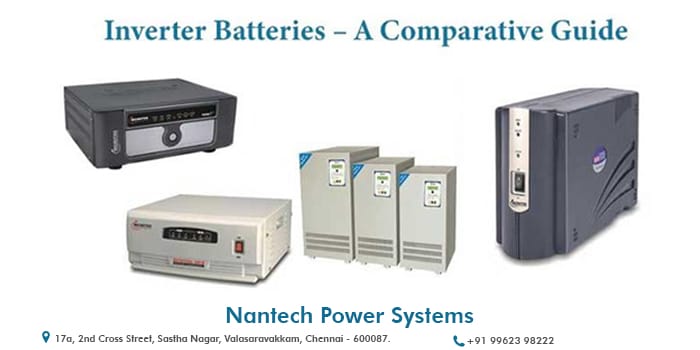
Inverters have become commonplace in homes and commercial establishments in India. In fact, as power cuts became a routine in Chennai, people have started to rely on inverters for continuous power supply to operate household appliances and commercial equipment. Inverters generate power from batteries. Let us learn more about inverter batteries, their types and their characteristics.
Batteries are storage devices capable of storing power. Inverters draw out the stored energy during power cuts. Inverters use batteries that are chargeable to generate electricity. They convert AC into DC which can power consumer appliances. They charge the batteries when the power supply is available.
There are different types of batteries in the market. Many consumers are often unaware of these types and are left wondering about which one to choose. When in doubt, it is best to get the opinion from experts. Nantech is a leading inverter tubular battery dealer in Chennai, with several years of experience in the field, and can guide you with the right choice.
Rechargeable batteries contain two electrodes dipped in an electrolyte solution. The electrodes are essentially two solid plates and the electrolyte is a liquid or a gel. The chemical reaction between the electrodes and electrolytes causes the formation of DC current. These chemical reactions are reversible, making the battery rechargeable. How interesting is that!
In a Lead Acid Battery, lead and lead dioxide are the electrodes, and sulphuric acid acts as the electrolyte solution. Electrodes dipped in sulphuric acid result in a chemical reaction that generates the DC current.
Often, people are misled by various terms used for inverter batteries. You may have heard about lead acid batteries, tubular batteries, flat plate batteries, etc. The commonly known batteries are the lead acid batteries. Let us now break a common misconception. Tubular batteries and flat plate batteries are two types of lead-acid batteries. Yes! People use lead acid batteries and flat plate batteries interchangeably, but in reality, tubular batteries are also lead acid batteries.
Thus, Lead-acid batteries are of two types– Flat plate batteries and Tubular Batteries.
Also Read: Why Is An Inverter Supplier In Chennai Important For Smart Homes?

Tubular batteries and flat plate batteries work on the same principle. However, there are some minor technical differences between the two.
The foremost difference is the positive plate. The positive plate is the critical component of the battery. The life of the battery depends on the structure of the plate. It is also a weaker plate and can wear out in the long run on repeated charging and recharging.
The structure of the positive plate is the primary distinguishing feature between the two types of batteries.
In a flat-plate battery, the positive plate is a grid-like structure, and due to the larger surface area, they are prone to corrosion. On the other hand, in the tubular battery, the active material is concealed inside tubes made of fabric replacing the positive plate. This tube ensures lesser corrosion and provides an increased life span to the battery.
Let us now have a comparative study of the two types of batteries. This will enable you to decide the one that fits your needs.
| Feature | Tubular Batteries | Flat Plate Batteries |
|---|---|---|
| Electrodes | Positive tube, Negative plate | Positive, Negative Plates |
| Battery Life | High (lasts up to 5 years) | Low (maximum of 3 years) |
| Efficiency | Lesser wastage of power | More wastage of power |
| Cyclic time | High | Low |
| Maintenance | Low | High |
| Charging time | Charges fast | Charges slower than tubular |
| Water Loss | Low water loss | Need periodic water toppings |
| Weight | Heavy | Light |
| Application | Suitable for high-end applications as well as homes | Suitable for small homes |
| Temperature | Can operate hassle-free in high temperature | Used at recommended temperature conditions |
| Price | Priced higher than Flat plate | Economical |
| Design | Complex | Simple |
In general, tubular batteries have at least 20% more electrical capacity than their flat plate counterparts. They are often called the deep cycle batteries due to their much greater run times.
We have listed the critical differences between the two types of batteries. When trying to buy a battery for residential or commercial use in Chennai, please keep these differences in mind and choose the right one that fits your power consumption needs.
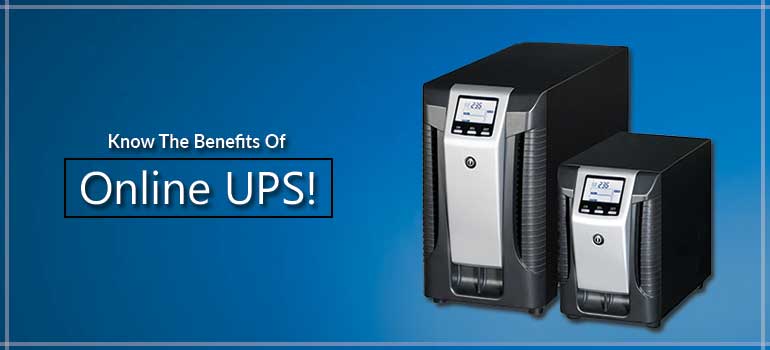
The Online UPS is a type of UPS that delivers power through the battery to the load as the batteries in it are directly connected to the inverter. This eliminates the need for a power switch in case of an online UPS. When the power supply fails, the UPS keeps on delivering power to the load with the help of the current drawn from the batteries. The conversion of this current is mainly through a DC- AC inverter. The current that comes in as AC is converted into DC which is used to charge the battery and the load through the inverter.
UPS Manufacturers In Chennai prefer the selling of Online UPS to offline UPS due to the long-term benefits it offers to the customers and the quality of the same. The working of UPS is such that the rectifier carries the load and starts charging the batteries once the power returns. This UPS works in the power range between 750 VA to 5000 VA.
Also Read: Questions To Ask Before UPS Purchase!
The technology involved in both Offline or Standby UPS and online UPS is almost the same. Online UPS Manufacturers In Chennai provide very high-quality Online UPS which has greater isolation from fluctuations in the main power supply. These are now not only available in very large power requirements up to 10 kW but also as a consumer device that supplies lesser power.
Online UPS has a higher initial installment cost but when compared with the long-term life of the battery, this is surely a great investment. The offline UPS has a lower initial cost due to the few parts it is made up of. Offline UPS are cheaper and simpler when compared with Online UPS. It has also fewer parts when compared with the many parts of Online UPS. Also, the operating temperature is much lower than that of the high temperature of Online UPS. The operating cost of offline UPS is lower and hence less electricity is needed for the same. One disadvantage of Online UPS is that since the inverter is always ON, the overall efficiency might be affected.
Online UPS is highly recommended in case of equipment that is highly sensitive to irregularities and fluctuations in power. The Online UPS has acceptance for extreme voltage fluctuations and does not need to rely on the battery all the time. Also, the output frequency is of fixed configuration. Since Online UPS does not have a switching mechanism and the inverter is ON at all times, there is no significant transfer time during the failure of power. In Online UPS, all kinds of disturbances like power spikes, blackouts, etc are not present. All this makes the voltage to be regulated better.
Online UPS provides protection to appliances at all times, no matter day or night. Online UPS is basically used in motor control applications as well as drives. It has applications in hospitals in the ICU and also in other medical equipment. Hence, if you are considering buying an online UPS, you should definitely try to know the technical as well as other aspects of the different types of UPS before making a choice.